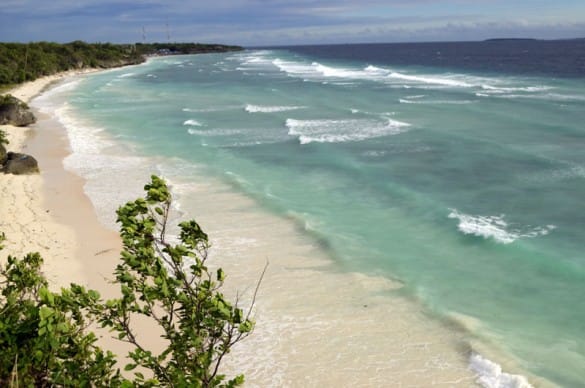“I go to seek a Great Perhaps.”
– François Rabelais
There can’t be many things in life that are better than a sandy beach in the tropics.
They don’t rust, they don’t break down and they don’t even need any maintenance (unlike many other things I could mention!) They inspire dreams. And, if we’re lucky, we may even get to visit them once in a while.
To find that fabled oasis in the sun is not as easy as it once was, however, and unlike 20 or 30 years ago, when you could simply just hop on a Garuda plane to Bali, a little more effort is now needed to get to a really nice Indonesian beach which is not either overrun by tourists or spoilt by rubbish.
A truly remote and isolated beach is not, however, an option for many people – either because of the considerable time and effort needed to get there or because of the lack of decent accommodation (which can turn that dream vacation into a proverbial holiday from hell).
So when someone told me about the sandy beaches at the southern tip of the bizarrely-shaped island of Sulawesi – just look at it on the map! – I naturally became intrigued.
The beaches lie close to a place called Tanjung Bira and to get there you first have to fly into the bustling city of Makassar. That’s the easy part. After that, it’s a long five to six hour journey on what, for Indonesia, is a remarkably good road, which takes you through small traditional Bugis towns and villages and across extensive coastal salt plains as you finally get closer to Bira.
The Bugis live in fine-looking and often brightly-painted wooden houses (rumah panggung) which are built on stilts. This is intended to offer protection from wild animals (okay I made that up) and keep the houses airy and cool, but they also look as if they could withstand some fairly serious flooding as well. A traditional solution to Jakarta’s perennial floods, perhaps?
About 15km on the road before Tanjung Bira is the boat-building village of Tanah Beru. The construction of traditional phinisi (schooners) has been done here for many hundreds of years now, and you will probably have already seen phinisi if you’ve ever visited the old Sunda Kelapa harbour in Jakarta. According to one of the young boat builders I spoke to at Tanah Beru, the construction of these magnificent boats is undertaken by adhering to the “knowledge” passed down through the generations, with no actual boat-building plans or measurements ever made – an amazing thought when everything seems to be written down or recorded in this day and age.
Any lingering doubts over the seaworthiness of the vessels are dispelled by elaborate ceremonies, one of which apparently involved the launching of newly-constructed schooners over the bodies of seven pregnant women. Fortunately for any aspiring mothers in the surrounding area, this particular ceremony is no longer carried out (perhaps the locals came to realize that the ceremony was having a rather detrimental impact on future generations rather than bringing any good luck).
You know you have arrived at Tanjung Bira when you come to one of those dreaded roadside lockets where you are asked to pay what is so endearingly termed in Indonesia as ‘retribution’. But since there is no gate, there is no real reason to stop and that’s exactly what the locals do; drive straight through without stopping. Just saying.
First impressions of Tanjung Bira are not actually that great to be honest. It has that kind of tired and neglected feel of a place which is struggling because of a lack of visitors. Bit like Anyer and Carita in Banten; ghost towns by the sea.
But Tanjung Bira isn’t really one place. It’s two. There’s the Tanjung Bira at the weekends when it’s packed with domestic tourists – mostly from Makassar and nearby Bulukumba – and the Tanjung Bira during the week when it’s pretty much deserted.
Dig deeper and Tanjung Bira reveals its secrets. First off, the beach at Tanjung Bira – while not exactly bad – is not that great either. However, only about 3km away is the nearby Bara Beach and this beach is a true discovery with its wonderfully powdery sand and crystal clear turquoise sea which abruptly turns to dark blue when the water gets deep. Being so secluded it’s very quiet and peaceful too.
Yet Indonesia wouldn’t be Indonesia without something completely unexpected and whacky going on. In Bira’s case, it’s a modestly-sized ‘entertainment’ district situated off the town’s main drag complete with seedy bungalows and a motley assortment of cheap karaoke bars. “Hindari pergaulan bebas & narkoba” (avoid free sex and drugs), reads one sign outside a, particularly ramshackle establishment. Well, you know what they say about sailors and seamen…
In short, Tanjung Bira is a great destination for seasoned travellers seeking a bit of solitude and clean, secluded beaches. More adventurous types can also go diving there – although the currents can be strong – and some decent snorkelling is usually possible at nearby islands (depending on the weather and the conditions of the sea). WiFi in Bira is, alas, rarer than a sighting of a Javanese tiger, so don’t expect to get access to the Net. Bring some books instead – or better still, your lover. After all, this is a holiday, isn’t it?
Fast Facts
Country: Indonesia
Province: Sulawesi Selatan
How to get there
Many airlines fly to Makassar as the city is the regional hub for air transportation in eastern Indonesia. From Makassar to Bira it’s a long 195km drive. The easy way to do this is to use a rental car (best booked in advance). A much more challenging proposition (but far cheaper) is to use public transportation; take a taxi from the airport to the Mellengkeri bus terminal (about 40 minutes) and from there you can get a small public minivan to Bira (although you may need to change in Bulukumba).
Best time to travel
Bira may be a suitable destination to avoid the monsoon season since its seasonality of rainfall is unlike that in Jakarta, Makassar or Bali. Generally dry for much of the year, most rain falls in the months of April, May and June.
Where to eat
The only decent restaurant is set back some way from the main beach, almost opposite the Wisma Bahari Indah hotel, and called Rumah Makan Cici.
What to do
- Bira has one renowned dive centre called Bira Divers (Tel: 081237200560).
- Visit an underground cave about 20 minutes away from Bira called P. Sohara Mandala Ria. After descending about 70 meters (bring a torch) you can swim in a cool, crystal-clear pool of spring water.
- Visit the nearby islands of Pulau Kambing and Liukang Island for snorkelling. A speedboat will cost about Rp.350,000 for the trip.




